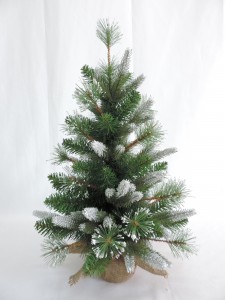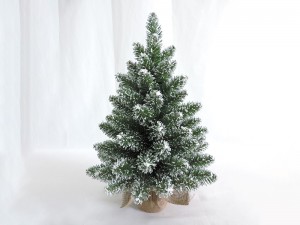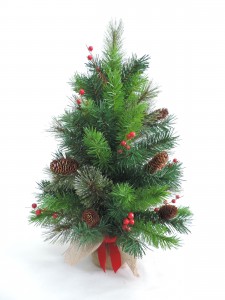When the time enters December, a tall Christmas tree is placed in front of commercial buildings, hotels and office buildings in many Chinese cities. Together with bells, Christmas hats, stockings and a statue of Santa Claus sitting on a reindeer sleigh, they convey the message that Christmas is near.
Although Christmas is a religious holiday, it has become part of popular culture in China today. So, what is the history of the Christmas tree, a key element of Christmas decoration?
From tree worship
You may have had the experience of walking alone in the quiet woods in the early morning or at dusk, where few people pass, and feeling extraordinarily peaceful. You are not alone in this feeling; mankind noticed long ago that the atmosphere of the forest could bring inner peace.
At the dawn of human civilization, such a feeling would lead people to believe that the forest or certain trees have a spiritual nature.
As a result, the worship of forests or trees is not uncommon throughout the world. The character "Druid", which appears in some video games today, is meant to be "the sage who knows the oak tree". They acted as clerics of primitive religions, leading people to worship the forest, especially the oak tree, but also use the herbs produced by the forest to heal people.

The worship of trees has lasted for many years, and the origin of the custom of the Christmas tree can actually be traced back to this. The Christian tradition that Christmas trees are made from evergreen coniferous trees that look like cones, such as firs, originated with a "miracle" in 723 AD.
At the time, Saint Boniface, a saint, was preaching in what is now Hesse in central Germany when he saw a group of locals dancing around an old oak tree that they considered sacred and were about to kill a baby and sacrifice it to Thor, the Norse god of thunder. After praying, St. Boniface swung his axe and cut down the old tree called "Donal Oak" with just one axe, not only saving the baby's life, but also shocking the locals and converting them to Christianity. The old oak tree that was cut down was split into planks and became the raw material for a church, while a small fir tree that grew up near the stump was considered a new sacred symbol because of its evergreen qualities.
From Europe to the world
It is difficult to determine whether this fir can be considered as the prototype of the Christmas tree; for it was not until 1539 that the first Christmas tree in the world, which looked similar to the present one, appeared in Strasbourg, located today near the German-French border. The most typical decorations on the tree, balls of various colors, large and small, probably originated from Portuguese folklore in the early 15th century.
At that time, some Portuguese Christian monks would make orange lights by hollowing out oranges, placing small candles inside and hanging them on laurel branches on Christmas Eve. These handmade works would become decorations for religious events, and through the evergreen qualities of the laurel in all seasons, they would be a metaphor for the exaltation of the Virgin Mary. But in Europe at the time, candles were a luxury that ordinary people could not afford. Therefore, outside of monasteries, the combination of orange lamps and candles was soon reduced to colored balls made of wood or metal materials.

However, it is also believed that the ancient Poles liked to cut down fir tree branches and hang them in their houses as decoration, and to attach objects such as apples, cookies, nuts and paper balls to the branches to pray to the gods of agriculture for a good harvest in the coming year;
the decorations on the Christmas tree are an absorption and adaptation of this folk custom.
At the beginning of the Christmas tree, the use of Christmas decorations was a cultural practice that belonged exclusively to the German-speaking world. It was thought that the tree would create a "Gemuetlichkeit". This German word, which cannot be translated exactly into Chinese, refers to a warm atmosphere that brings about inner peace, or the feeling of happiness that comes to everyone when people are friendly with each other. Over the centuries, the Christmas tree has become a symbol of Christmas and has been incorporated into popular culture even in countries and regions outside of Christian cultural circles. Giant Christmas trees placed near some tourist destinations are recommended by travel guides as seasonal landmarks.
The environmental dilemma of Christmas trees
But the popularity of Christmas trees has also created challenges for the environment. Using Christmas trees means cutting down forests of naturally growing coniferous trees, which are usually found in colder places and don't grow very fast. The high demand for Christmas trees has caused coniferous forests to be cut down at a rate that far exceeds their natural recovery.
When a natural coniferous forest disappears completely, it means that all other life that depends on the forest, including various animals, plants and fungi, will also die out or leave with it.
In order to alleviate the demand for Christmas trees and the destruction of natural conifer forests, some farmers in the United States have designed "Christmas tree farms," which are artificial woodlots composed of one or two types of fast-growing conifers.
These artificially cultivated Christmas trees can reduce the deforestation of natural forests, but also create a piece of "dead" forest, because only very few animals will choose to inhabit such a single species of woodland.

And, like Christmas trees from natural forests, the process of transporting these planted trees from the farm (forest) to the market, where the people who buy them drive them home, produces a staggering amount of carbon emissions.
Another idea to avoid destroying natural coniferous forests is to mass produce artificial Christmas trees in factories using recyclable materials, such as aluminum and PVC plastic. But such a production line and the transportation system that goes with it would consume just as much energy. And, unlike real trees, artificial Christmas trees cannot be returned to nature as fertilizer. If the waste separation and recycling system is not good enough, the artificial Christmas trees that are abandoned after Christmas will mean a lot of waste that is difficult to degrade naturally.
Perhaps forming a network of rental services to ensure that artificial Christmas trees can be recycled by renting them instead of buying them is a viable solution. And for those who love real conifers as Christmas trees, some specially bred coniferous bonsai can take the place of a traditional Christmas tree.
After all, a downed tree means irreversible death, requiring people to keep cutting down more trees to fill its place; whereas a bonsai is still a living thing that can stay with its owner in the home for years.
Post time: Dec-05-2022